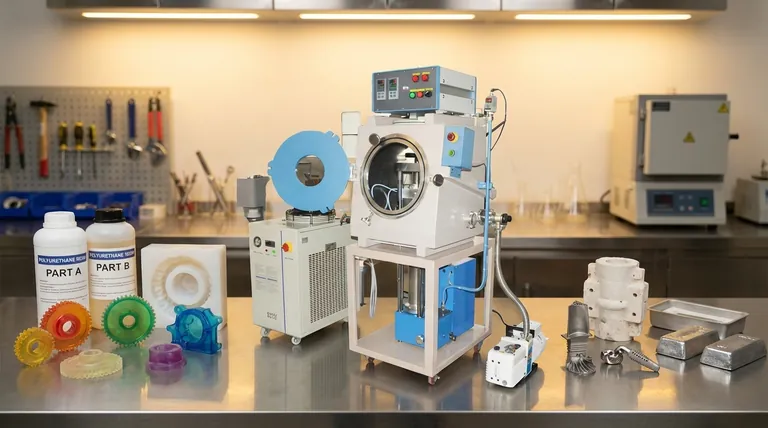The term "vacuum casting" is often used to describe two distinct manufacturing processes, one for polymers and another for metals. For polymers, the process uses a range of polyurethane resins designed to mimic production plastics, creating high-fidelity prototypes. For metals, vacuum investment casting is used for high-performance alloys where purity is critical, such as superalloys, stainless steels, and titanium.
The specific material you can vacuum cast depends entirely on which process you are referring to. The choice is between polyurethane resins for creating plastic-like parts in silicone molds, or high-performance metals like superalloys and titanium for creating critical components in ceramic molds.

Deconstructing "Vacuum Casting": Two Key Processes
To understand the material options, you must first identify which "vacuum casting" process fits your goal. They solve very different problems and do not share the same materials or equipment.
Process 1: Urethane Vacuum Casting (For Polymers)
This process is primarily used for prototyping and low-volume production of plastic-like parts. It involves pouring a liquid polymer resin into a flexible silicone mold inside a vacuum chamber.
The materials used are two-component polyurethane resins. These are formulated to simulate the properties of common production plastics.
Common material families include:
- ABS-like: General-purpose, rigid resins with good impact strength.
- Polypropylene (PP)-like: Semi-rigid resins offering good flex and durability.
- Rubber-like (Elastomeric): Flexible resins with varying Shore hardness values to mimic rubber.
- Clear (PC or Acrylic-like): Transparent resins used for lenses and see-through components.
- High-Temperature Resistant: Specialty resins that can withstand higher operating temperatures.
Process 2: Vacuum Investment Casting (For Metals)
This is a highly specialized industrial process for creating complex, high-performance metal parts. A wax pattern is used to create a ceramic mold, which is then filled with molten metal under a vacuum.
This process is reserved for metals that are highly reactive with oxygen or require absolute purity and a flawless internal structure.
Materials frequently used include:
- Nickel-Based Superalloys: (e.g., Inconel, Hastelloy) used in aerospace and turbine engines for their extreme temperature and corrosion resistance.
- Titanium Alloys: Used for medical implants, aerospace components, and military hardware where high strength-to-weight ratio and biocompatibility are essential.
- Stainless Steels: Used for complex parts that require high corrosion resistance and strength.
- Aluminum Alloys: Used for lightweight aerospace and automotive components that demand high integrity.
Why Use a Vacuum? The Core Benefits
The role of the vacuum is fundamentally about ensuring quality by removing air and other gasses from the process.
For Urethanes: Bubble-Free, Perfect Copies
The vacuum removes all air from the liquid resin and the mold cavity before the material is introduced. This ensures there are no air bubbles or voids in the final part and that the resin fills every tiny detail of the mold, creating a perfect replication of the master pattern.
For Metals: Purity and Performance
In metal casting, the vacuum serves two critical functions. First, it prevents oxidation by removing oxygen that would otherwise react with the molten metal, which is crucial for reactive alloys like titanium and superalloys.
Second, the pressure differential helps pull the molten metal into very intricate and thin-walled sections of the mold, which might not fill completely under a simple gravity pour.
A Note on Other Vacuum Processes
It is easy to confuse vacuum casting with other manufacturing processes that also take place in a vacuum. The materials mentioned in your references are for these distinct processes, not for casting.
- Vacuum Sintering: Fuses powdered metals or carbides together under heat and vacuum, without melting them.
- Vacuum Tempering: A heat treatment process that alters the hardness and ductility of already-formed steel parts.
- Vacuum Nitriding: A surface-hardening treatment for finished parts to improve wear resistance.
These are not casting processes because they do not involve pouring a liquid material into a mold to create the part's shape.
Making the Right Choice for Your Goal
To select the correct process and material, you must be clear on your project's final objective.
- If your primary focus is creating high-fidelity plastic prototypes or small production runs (10-100 units): Urethane vacuum casting with polyurethane resins is your ideal choice.
- If your primary focus is manufacturing complex, mission-critical metal parts with no impurities: Vacuum investment casting with materials like superalloys, titanium, or specialty steels is the required process.
- If you need to harden or modify an existing metal part: You should investigate separate heat treatment processes like vacuum tempering or nitriding, not casting.
Ultimately, aligning your material choice with the correct manufacturing process is the foundation for a successful outcome.
Summary Table:
| Process | Materials Used | Key Applications |
|---|---|---|
| Urethane Vacuum Casting | ABS-like, PP-like, Rubber-like, Clear, High-Temp Resins | Prototyping, low-volume production of plastic-like parts |
| Vacuum Investment Casting | Nickel Superalloys, Titanium Alloys, Stainless Steels, Aluminum Alloys | Aerospace, medical implants, high-performance metal components |
Need expert guidance on vacuum casting for your project? Whether you're creating durable plastic prototypes or complex metal parts with high-performance alloys, KINTEK has the expertise and equipment to support your laboratory and manufacturing needs. Contact us today to discuss your material and process requirements!
Visual Guide

Related Products
- Vacuum Hot Press Furnace Machine for Lamination and Heating
- Automatic Lab Cold Isostatic Press CIP Machine Cold Isostatic Pressing
- Manual Cold Isostatic Pressing Machine CIP Pellet Press
- Custom PTFE Wafer Holders for Lab and Semiconductor Processing
- Three-dimensional electromagnetic sieving instrument
People Also Ask
- What is vacuum lamination? Achieve a Flawless, Durable Finish on Complex Shapes
- What is hot press forging? Creating Complex, High-Strength Metal Components
- How does hot pressing work? Achieve Maximum Density for Advanced Materials
- What are the advantages and disadvantages of hot pressing? Choose the Right Powder Metallurgy Process
- What are the advantages and disadvantages of hot stamping? Unlock Ultra-High Strength for Automotive Parts



















